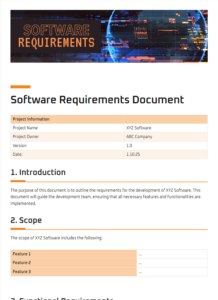Crafting a comprehensive and effective software requirements document (SRD) is crucial for software development projects. A well-structured SRD ensures that stakeholders are on the same page, reducing the risk of costly rework and miscommunication. In this article, we provide you with a simple software requirements document template that will guide you through the process of creating a robust SRD.
Before delving into the sections of the document, it is important to understand the purpose and benefits of an SRD. It serves as a blueprint for the software development team, outlining the project’s objectives, scope, functionalities, and constraints. A well-written SRD fosters collaboration and transparency, ensuring that the final product meets the business’s needs and user expectations.
Sections of a Simple Software Requirements Document Template
The sections of a simple software requirements document template typically include:
Introduction: This section provides an overview of the SRD, including its purpose, scope, and intended audience. It sets the stage for the rest of the document.
Business Requirements: This section outlines the business objectives that the software is intended to achieve. It describes the business processes, workflows, and user needs that the software must address.
Functional Requirements: This section defines the specific functionalities that the software must provide. It outlines the input, output, and processing requirements for each functionality.
Non-Functional Requirements: This section addresses the overall quality attributes of the software, such as performance, usability, security, reliability, and scalability. It sets the standards that the software must meet.
Tips for Writing an Effective SRD
To ensure the effectiveness of your SRD, consider the following tips:
Use Clear and Concise Language: Write in a manner that is easy to understand by both technical and non-technical stakeholders. Avoid jargon and technical terms that may not be familiar to all readers.
Prioritize Stakeholders: Identify the key stakeholders involved in the project and tailor the SRD to their needs. Ensure that the document is clear and relevant to each stakeholder group.
Seek Feedback and Iteration: Share the SRD with stakeholders early on and seek their feedback. Iteratively revise and refine the document based on the feedback received.
Keep it Manageable: While providing comprehensive details, avoid creating an overly long and unwieldy SRD. Keep the document concise and focused on the essential requirements.
Utilize Visual Elements: Enhance the readability and understanding of your SRD by incorporating diagrams, flowcharts, and tables. These visual elements can simplify complex concepts and provide a clear overview of the software’s requirements.
Conclusion
By utilizing a simple software requirements document template and adhering to the best practices outlined above, you can create a robust and effective SRD. This will serve as a valuable asset throughout the software development lifecycle, ensuring that the final product meets the intended objectives and delivers value to the business.
Remember, a well-written and well-managed SRD is not just a document but an essential tool for successful software development projects. Embrace the opportunity to create a clear and comprehensive SRD, and you will reap the benefits of a streamlined development process and a high-quality software solution.

